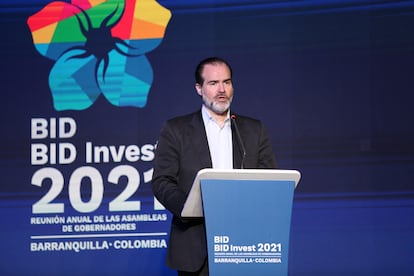Note to readers: EL PAÍS offers openly all the content of the Future Planet section for its daily and global contribution to the 2030 Agenda. If you want to support our journalism,
subscribe here.
After more than two centuries of independence, Latin America and the Caribbean continues to be a tributary of the exports of its raw materials.
However, the covid-19 pandemic, which plummeted international trade, brings a new opportunity for Latin American countries:
nearshoring.
For the Inter-American Development Bank (IDB), this phenomenon has led multinational companies to relocate their production to nearby countries and should be used by the region now that it plans to recover.
More information
A winning strategy against inequality: invest only in what works
The fruits of three decades of innovation
The IDB warns that without economic reforms there will be no recovery in Latin America
A fund to save the Amazon compatible with economic growth
According to the
IDB's 2021 Macroeconomic Report
, presented last week at the Annual Meeting of Governors, the growth prospects for Latin America and the Caribbean for 2021 are uncertain.
The hypothesis is that the region will grow only 4.1%, after having fallen 7.4% last year.
This steep decline left 26 million Latin Americans unemployed and a possible five percentage point increase in extreme and moderate poverty.
For Mauricio Claver-Carone, president of the IDB, Latin American countries can benefit from
nearshoring
, "so that the relocation of production translates into more economic activity and more and better jobs."
To that end, at its annual meeting, the agency announced that it will make a series of financial and non-financial tools available to Latin American countries and companies.
These include sovereign guaranteed and non-sovereign guaranteed loans, grant financing for technical cooperation programs, and advisory services.
Despite the criticism it has received for this bet, Claver-Carone has reaffirmed itself to be "a great seller in the region."
"I am going to sell it to all global investors in the United States, Europe and elsewhere, because the opportunity we have is generational and it is not only a duty, it is a responsibility," he said.
Latin America and the Caribbean still have a low participation in global value chains, those in which companies place part of their production processes in other countries.
"It is curious that many industries, for example, in the United States, have their second global settlement base in Asia, but not in Latin American countries," said Colombian President Iván Duque during the virtual session.
"Colombia is not discussing whether or not it wants to enter
nearshoring
, but how to accelerate this process."
In addition to its low participation, the region still contributes little added value to its exports, since they are concentrated in raw materials.
This brings a disadvantage, since within value chains the benefits are not distributed equally, with innovation, design and commercialization being more valued.
According to the IDB, in the last 30 years, the foreign added value that Latin American countries have incorporated into their exports has been between 18 and 19%, while in Asia it reaches 33% and 43% in the European Union.
Colombia is not discussing whether or not it wants to enter
nearshoring
, but how to accelerate this process
Iván Duque, President of Colombia
"Although it sounds cliché, Colombia has a position and a comparative advantage from its geography and its biodiversity to offer many new things," said Jorge Zapata, president of the multinational agroindustrial Ingredion for the Andean region.
"Let's not bring high-value starches to the market, let's bring colorants, flavors, all that range of products that require not only agriculture, but also industrialization."
For Mariana Guerrierre, director of IBM's Cognitive Transformation Center in Colombia, Latin American countries are attractive for companies to invest in technology and not just in raw materials.
“We trust in the talent of the people and in the capacities of this investment territory.
We have to bet on Colombia and the region so that we can see their integration with the rest of the world, "he said.
Mauricio Claver-Carone, president of the IDB, during the organization's annual meeting.
Despite this potential, restrictive trade policies, high transportation costs, and lags in logistics performance and connectivity infrastructure persist in these countries.
All of these are limitations that the IDB seeks to overcome in its 26 borrowing countries.
According to his calculations, this could lead to an increase of 70,000 million dollars in the region's exports to the United States with gradual increases in sectors such as textiles, medical products and automobiles.
But all these efforts to connect Latin America and the Caribbean with the world will be in vain without integration within the same region.
In this regard, Fabrizio Opertti, manager of the IDB's trade and integration sector, argued that trade between Latin American countries has decreased in recent years and remains below 15%, while in Europe it reaches almost 60% and in Asia more than 40%.
“We have a pending agenda of convergence of more than 33 preferential trade agreements.
Only the convergence and harmonization of these agreements implies an annual increase in intra-regional trade close to 12% ”.
For the Secretary General of the Organization for Economic Cooperation and Development (OECD), Angel Gurría, Latin Americans have been thinking about such integration for decades without success.
“Now that our economies are planning to recover, we have to talk about more inclusive and certainly greener growth.
And this is through greater diversification and integration of regional value chains ”.
FUTURE PLANET can follow on
,
and
, and subscribe
here
to our 'newsletter'
.









